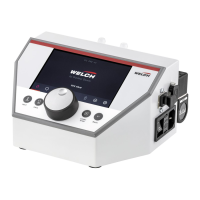
Do you have a question about the Gardner Denver Welch VCpro 600 Series and is the answer not in the manual?
| Control | Digital |
|---|---|
| Type | Controller |
| Series | VCpro 600 |
| Manufacturer | Gardner Denver Welch |
| Display | LCD |
| Power Supply | 100-240 VAC, 50/60 Hz |
| Enclosure Rating | IP20 |
| Control Modes | Automatic, Manual |
| Communication Interface | RS-485 |
| Storage Temperature | -20°C to 60°C |
User instructions and responsibilities regarding manual usage and safety.
Explanation of visual symbols used for warnings and information in the manual.
Detailed meanings and visual representations of all safety symbols in the manual.
Glossary of abbreviations and their corresponding technical designations.
General safety guidelines and personnel requirements for operating the device.
Instructions on the intended applications and conditions for correct device operation.
Definition and examples of uses considered improper for the device.
Identification of potential misuse scenarios that must be avoided by the operator.
Specifies required qualifications for users and specialized personnel.
Details responsibilities of users, specialized personnel, and workshops for various activities.
Essential protective measures and personal safety requirements during operation.
Identification and mitigation of specific hazards associated with the device's operation.
Safety instructions for handling hazardous materials conveyed by the system.
Precautions and limitations regarding operation in potentially explosive atmospheres.
Safety guidelines for electrical connections and hazards associated with electricity.
Safety considerations related to the device's mechanical components and operation.
Safety precautions concerning vacuum conditions and potential hazards.
Safety implications of specific system functions like 'Allow ventilation' and 'Auto Start'.
Security measures for network-capable operation to prevent unauthorized access.
Specifications and characteristics of the device, including electrical, environmental, and physical data.
Details on serial, LAN, and control connections, including pin assignments.
Information on connections for inert gas, vacuum apparatus, and vacuum pump.
List of components that come into contact with internal gases and their materials.
Overview of the vacuum controller's purpose and primary functions in vacuum processes.
Description of the device's housing, layout of operating elements, and rear/side connections.
Explanation of the device's user interface, buttons, and navigation structure.
Detailed description of toolbar, display fields, and button bar functions.
Explanation of the three-level user interface navigation structure.
Identification and diagrams of the different VCpro vacuum controller models.
Detailed description and connection diagram for the VCpro 601 model.
Detailed description and connection diagram for the VCpro 602 model.
Visual guide to symbols used on the rear panel of the vacuum controller.
Information on available interfaces for PC connection and optional units.
List and details of optional accessories available for the vacuum controller.
Instructions for carefully unpacking the device and checking its completeness.
Guidelines for proper device placement, ventilation, and vacuum line connections.
Procedures and safety precautions for making the electrical connection.
Instructions for connecting LAN and serial communication interfaces.
Recommendations for storing the device in a suitable environment.
Steps to safely connect and power on the vacuum controller for initial operation.
Overview of different operating modes and system configuration options.
Description of the Manual operating mode for manual pressure setpoint adjustment.
Details on the Automatic mode for material separation based on boiling points.
Instructions for programming custom pressure profiles and cycles.
Information on the Multi-pump operating mode (currently unavailable).
Procedure for the Self-cleaning mode to purge and dry the system.
Configuration options for language, display, control system, and maintenance timer.
Procedures for setting up access control and log file configurations.
How to set USER and ADMIN passwords for device security.
Steps for creating, setting frequency, and displaying log files.
Procedure to revert the device settings to their original factory defaults.
Overview and installation of the PC software for remote control and firmware updates.
Detailed steps for downloading and installing the PC-Control 601 software.
Guide to establishing communication between the PC and the vacuum controller via RS232 or LAN.
Description of the PC software's main interface elements and their functions.
Options for saving/loading settings, managing pressure data, and printing curves.
Instructions for displaying, saving, and deleting log files from the controller and PC.
Configuration of global settings and parameters for individual operating modes.
Procedure for performing two-point calibration of the vacuum controller.
Steps for updating the device's firmware using the PC software.
Table of solvents and their corresponding vapor pressures for pressure setpoint selection.
Guidelines for regular servicing, inspection, and cleaning of the device.
Instructions for cleaning components that contact media using suitable solvents.
Procedure for device repair, including damage report requirements and sending for service.
Environmental regulations and procedures for the proper disposal of the device.
Troubleshooting steps for device power and display issues.
Diagnosing and resolving issues with the VCpro 601 vacuum control valve.
Troubleshooting faults related to connected valves and pumps when the display is functional.
Resolving issues where the controller is unresponsive to setting or programming commands.
Steps to correct an incorrectly set language setting on the device.
Procedures for unlocking the device when access is restricted by password.
Troubleshooting PC communication issues, including network and IP settings.
Resolving inaccurate pressure readings due to calibration or cable issues.
Guidance on identifying and replacing faulty cables.
Comprehensive list of available spare parts with order numbers for the device.
Contact information for ordering parts and requesting service support.
Official declaration confirming the product's compliance with EU directives and standards.
Section for additional notes or remarks not covered elsewhere in the manual.